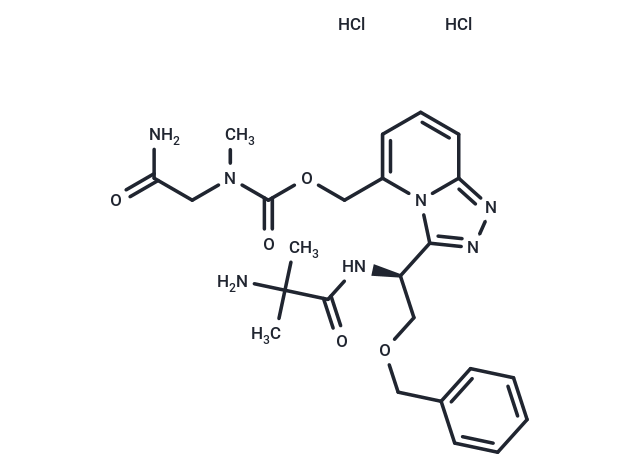Shopping Cart
Remove All Your shopping cart is currently empty
Your shopping cart is currently empty
BMS-604992 (EX-1314) dihydrochloride is a selective, orally active small-molecule agonist of the growth hormone secretagogue receptor (GHSR). It exhibits high-affinity binding (k i = 2.3 nM) and potent functional activity (EC 50 = 0.4 nM). Additionally, BMS-604992 dihydrochloride stimulates food intake in rodents.

| Pack Size | Price | USA Warehouse | Global Warehouse | Quantity |
|---|---|---|---|---|
| 5 mg | $970 | Inquiry | Inquiry |
| Description | BMS-604992 (EX-1314) dihydrochloride is a selective, orally active small-molecule agonist of the growth hormone secretagogue receptor (GHSR). It exhibits high-affinity binding (k i = 2.3 nM) and potent functional activity (EC 50 = 0.4 nM). Additionally, BMS-604992 dihydrochloride stimulates food intake in rodents. |
| Targets&IC50 | GHSR:0.4 nM (EC50), GHSR:Ki: 2.3 nM |
| In vitro | BMS-604992 demonstrates high-affinity binding (K i =2.3 nM) and potent functional activity (EC 50 =0.4 nM) at the ghrelin receptor[1]. |
| In vivo | BMS-604992 demonstrates diverse pharmacological activities across different dosages and administration methods in animal studies. At a dosage of 500 μg/kg administered intraperitoneally (i.p.) for 5 minutes, it significantly enhances gastric emptying in C57BL/6 mice compared to those receiving a vehicle[1]. When given orally (p.o.) at dosages ranging from 1 to 1000 mg/kg for 1 hour, BMS-604992 shows a linear relationship between dose and plasma concentration at the 1-hour mark, along with a dose-dependent increase in food consumption in C57BL/6 mice, identifying a minimum effective dose of approximately 10 mg/kg[1]. A specific 300 mg/kg oral dosage results in a notable difference in effect within just 5 minutes in SD rats[1]. Lastly, an i.p. administration of 500 μg/kg over 4 hours leads to a twofold increase in food intake in male GhrR KO and WT mice compared to vehicle-treated controls[1], highlighting its potential impact on feeding behavior and gastric processes. |
| Synonyms | EX-1314 dihydrochloride, BMS-604992 dihydrochloride |
| Molecular Weight | 570.47 |
| Formula | C24H33Cl2N7O5 |
| Cas No. | 1469750-46-6 |
| Smiles | Cl.Cl.CN(CC(N)=O)C(=O)OCc1cccc2nnc([C@@H](COCc3ccccc3)NC(=O)C(C)(C)N)n12 |
| Storage | Powder: -20°C for 3 years | In solvent: -80°C for 1 year | Shipping with blue ice/Shipping at ambient temperature. |
| Size | Quantity | Unit Price | Amount | Operation |
|---|

Copyright © 2015-2025 TargetMol Chemicals Inc. All Rights Reserved.